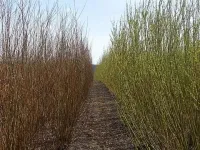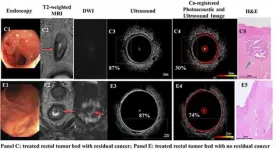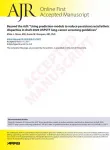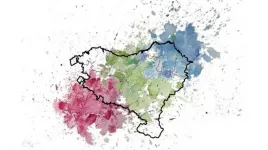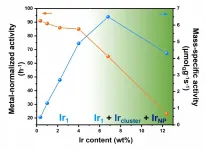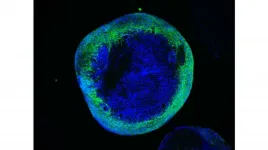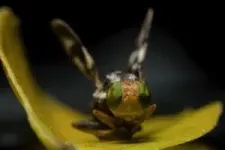(Press-News.org) Renewable energy demand and consumption is at an all-time high in the United States.
Shrub willow - a quick-growing woody crop - can be an excellent source of renewable bioenergy. The crop is harvested and turned into wood chips, which can be used for heat, mulch, animal bedding, biochar, and biofuel.
In a new study, researchers grew shrub willow on a semi-commercial scale to better understand the nuances of this bioenergy crop. The research was published in Agronomy Journal, a publication of the American Society of Agronomy.
"We learned and developed key know-hows that we can transfer to industry partners interested in this crop," says Armen Kemanian. Kemanian is a member of the American Society of Agronomy and is the lead author of the study.
Insights include determining which willow varieties to plant and how to best handle planting and harvesting.
"Starting a willow crop can be expensive," says Kemanian. "It also requires a perfectly choreographed operation to keep costs low and yields high."
But shrub willow also offers several advantages as a bioenergy crop.
"Shrub willow thrives in wetter areas with cold winters and mild summers," says Kemanian. That makes the crop well-suited to New England and parts of the upper Midwest.
Other bioenergy crops, such as switchgrass, grow better in areas of the U.S. with warmer summers.
According to Kemanian, "Shrub willow can be part of a geographically diverse combination of bioenergy crops."
One important quality of shrub willow is its ability to store a tremendous amount of carbon. That's beneficial because when there is more carbon stored in plants, there is less carbon in the atmosphere.
When the carbon is in the atmosphere as carbon dioxide, it can be a harmful greenhouse gas. But when the carbon is in the plant, it doesn't pose a risk to the environment.
Shrub willow also has tremendous genetic variability. That's important for breeding key crop characteristics, such as pest resistance.
"The study found that planting a mixture of willow varieties is critically important," says Kemanian.
That's because some highly productive willow varieties attract pests, like the willow leaf beetle. Surrounding these high-yield willow varieties with beetle-resistant varieties can slow down the pests.
"This is a different strategy compared to growing annual crops," explains Kemanian.
Annuals can be replanted every year. In contrast, shrub willow can be harvested every two to four years for more than 20 years. "Growing different varieties together is critical," says Kemanian.
The relatively long lifespan of willow crops also means that planning is vitally important.
"Harvest costs account for a large fraction of total operation cost over the life cycle of willow crops," says Kemanian.
The study established that a well-designed field is easier to harvest. That might seem obvious, but some of the findings are counterintuitive.
For example, while yields are important, seeking the highest possible yield per unit area is not the most critical parameter when planning willow planting schemes.
"Designing fields and plantings so that harvest machinery traffic is efficient is more important," says Kemanian.
However, the study also found that - at least on semi-commercial scales - actual willow yields could be lower than the expected yield potential.
"Willow thrives in productive soils," says Kemanian. "Rocky soils can increase planting and harvest cost and lower yields."
Researchers suggest that when it comes to growing shrub willow, the harvestable crop isn't the only valuable outcome for farmers.
"We should also monetize the ecosystem services that willow provides," says Kemanian.
These services include storing carbon, hosting pollinators, reducing water runoff, and retaining nutrients - such as nitrogen - in the soil.
"Willow can play a significant role in improving our most intensely farmed land," says Kemanian. "We just need to take advantage of the synergies between animal production and crop production."
But quantifying the ecosystems services of willow at a large scale remains complicated. "We can tackle this challenge with computer modeling," says Kemanian. "That's something our team is doing right now."
Other next steps include monitoring for pest outbreaks with unmanned aerial vehicles (UAVs). These UAVs could also be used to detect and control pests efficiently and economically.
"Ultimately, we think willow can play a role in regenerative and climate-smart agriculture," says Kemanian.
INFORMATION:
Armen Kemanian is an associate professor and researcher at Pennsylvania State University. This work was supported by the NEWBio project and the United States Department of Agriculture's National Institute of Food and Agriculture.
Rectal cancer, along with colon cancer, is the third-most common type of cancer in the United States, and treatment and surgery greatly affect the quality of life of patients. A multi-disciplinary team at Washington University in St. Louis has developed and tested an innovative imaging technique that is able to differentiate between rectal tissues with residual cancers and those without tumors after chemotherapy and radiation, which could one day help to avoid unnecessary surgeries in some patients who have achieved complete tumor destruction after chemoradiation.
Quing Zhu, PhD, professor of biomedical engineering at the McKelvey School of Engineering, and members of her lab developed ...
The Institute for Quality and Efficiency in Health Care (IQWiG) revised its methods paper and published the German original version "Allgemeine Methoden 6.0" (General Methods 6.0) on http://www.iqwig.de in November 2020. This document is the basis for the scientific work of the Institute and its external experts as well as for the collaboration with its contracting agencies, the Federal Joint Committee (G-BA) and Federal Ministry of Health (BMG). The English translation is now available on http://www.iqwig.de/en/about-us/methods/methods-paper/.
New features include statements on the investigation of the relationship between volume of services and quality, a section on different treatment periods in studies, and a more concrete approach to the assessment of clinical relevance.
In ...
Scientists have developed a method to use lasers to control the movement of nanodiamonds with fluorescent centers.
Scientists have long been working on improving their ability to use lasers to move small objects without actually touching them. This method of 'optical trapping and manipulation' is already utilized in optics, biological sciences and chemistry. But objects become much more difficult to control once they grow to nanoscale size.
Now, a team of scientists including Hokkaido University's Keiji Sasaki and Osaka Prefecture University ...
Leesburg, VA, March 26, 2021--According to ARRS' American Journal of Roentgenology (AJR), updated United States Preventive Services Task Force (USPSTF) lung cancer screening (LCS) guidelines based solely on age, pack-years, and quit-years perpetuate eligibility disparities among racial and ethnic minorities, although incorporating certain risk prediction models may help reduce such inequalities.
By pulling data from the 2015 National Health Interview Survey (NHIS), Journal of the National Cancer Institute researchers (Landy et al.) were able to "estimate the effects of USPSTF-2020 guidelines on disparities in LCS eligibility for the non-institutionalized civilian US population," wrote Massachusetts ...
The Basques are a unique population in Western Europe; their language is not related to any Indo-European language. Furthermore, genetically speaking, they have been considered to have distinct features. However, until now there was no conclusive study to explain the origin of their singularity.
Now, an international research team led by UPF has confirmed that the Basques' genetic uniqueness is the result of genetic continuity since the Iron Age, characterized by periods of isolation and scarce gene flow, and not its external origin in respect of other Iberian populations.
The study, led by David Comas, principal investigator at UPF and at the Institute of Evolutionary Biology (IBE: CSIC-UPF), has involved ...
Atomically dispersed catalysts have received extensive research attention, because they exhibit excellent activity and unique selectivity for many important catalytic reactions. The atomically dispersed nature of these metal catalysts confers their unique electronic structures as well as designated coordination-unsaturated environments for the optimized adsorption/activation of the reactants. One grand challenge faced by these atomically dispersed catalysts is that the supported isolated metal \atoms are usually thermally unstable and tend to aggregate into large clusters/particles at evaluated reaction temperatures. As a result, most reported atomically dispersed catalysts have an extremely low metal loading below ...
Every year, millions of people around the world are displaced from their homes due to severe weather caused by climate change. According to the International Red Cross and Red Crescent Movement, 10.3 million people were displaced as a result of climate-?related events in the last six months alone - four times the number displaced by war and conflict in the same period. One of the main causes of displacement is flooding. A recent example is the situation in eastern Australia, where tens of thousands of people are having to flee their homes to seek safety from this hundred-?year flood.
An international research team led by the Weather ...
The skin is the largest organ in the human body, and its outermost part, called the epidermis, is replenished every three weeks. The cells fueling this renewal of the epidermal stem cells, found in specialized areas or niche, within a region of the hair follicle (or root) is known as the 'bulge compartment'. The bulge compartment resident stem cells are multipotent meaning that they can contribute to the repair of skin when it's injured, and also regenerate the hair follicles during normal development. While several groups have focused attention on the stem cells themselves, less is known about niche or extrinsic factors that influence the state of these stem cells.
In the recent paper published in the Developmental Cell, ...
Leigh syndrome is the most severe mitochondrial disease in children. It causes severe muscle weakness, movement defects, and intellectual disabilities. It usually leads to death within the first years of life. No causative treatment is currently available. One of the genes frequently mutated in patients is SURF1, which encodes for a protein involved in the process of energy generation in the cells. Animal models did not recapitulate the defects seen in the patients carrying mutations in SURF1. Therefore, the scientists did not have the tool to start understanding the disease mechanisms and to identify possible targets for treatment. They report about the first ...
Apple flies have fascinated scientists right from the mid-19th century, as they are a captivating example of speciation, the beginning of a new species. Correspondence between Charles Darwin and Benjamin Walsh, who observed the apple flies and hawthorn flies in North America, began the rich history of this scientific question in evolutionary biology. When settlers in North America introduced apple trees to the region, what happened within the hawthorn flies to make them shift to this new host plant in the last 300 years?
Continuing the 160-year-old inquiry into the origins of the apple fly, a team of scientists from around the world has just published their research in the Proceedings of the Royal Society B. The researchers span three continents, from the National Centre for Biological ...
